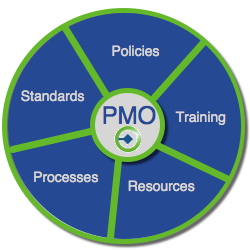Projects happen in just about every organization. There may or may not be a formal project management process in place in an organization, but projects are still happening all around. Inside business units need work done. Outside clients need new services, software, and reports or tweaks to existing solutions already in place. Projects just happen.
Ideally, we’re ready to meet those needs with some formal project management practices in place. And what better way to meet those needs than to have that PM structure rolled into its own self-contained organization that is responsible for projects and only projects? What better way to handle these periodic engagements than to see to it that they are managed consistently, effectively, efficiently and solely by one office…one group of individuals who comprise the project management office or PMO?
PMOs are great if you’re doing them right. If a PMO is created and not utilized well, not funded well, not staffed well, or not given leverage within your organization, it can be a disaster…or at least a big waste of time and resources. And if you create a PMO and yet it fails to live up to its end of the bargain of basing its ongoing performance on some key principles and then consistently delivering, then it will likely wither away as executives bypass the PMO and send projects to their own ‘people’ who they consider to be ‘more reliable’ and ‘working in their best interest’.
I’ve worked in an organization where the project management office was not a consistent deliverer of success. We struggled to put processes in place that everyone followed. And quickly, executive management ignored us and used their own people within each business unit to oversee projects. We still managed projects, but only about 1/3 of the projects went through the PMO, when obviously all should use your organization’s PMO – that’s what it was created for. We were a charge-back unit, so slowly we were less and less profitable until the PMO became an albatross that couldn’t pay for itself. Yes, the next step was to disband and that is exactly what happened.
For a project management office to be viable – and remain viable – in an organization, then it needs to….at least in my opinion….meet these three criteria…
Have management or insight into all internal and external projects. Your PMO must be the go-to organization for all projects. Even if a BU wants to handle it’s own project, the PMO should be involved – consulting on best practices, involved in some meetings with the customer, and generally ensuring that processes are being followed and standardized reporting is actually happening. In short, any periodic project run outside of the formal PMO structure must look like those run inside – the customer must see consistent delivery and that begins and ends with the PMO.
Deliver consistency – both success and processes. No one can guarantee project success, but when an organization develops sound project management practices and processes and FOLLOWS them, then the likelihood of experiencing success and repeating success is much higher. The PMO must be built on repeatable processes, best practices for standard project status reporting and status meetings and budget management, etc. and develop documents and templates that the project managers within the PMO can use to consistently deliver the same type of project management across all of the projects that are being handled.
Be visible to and keep approval of senior company leadership. Funding and backing is critical. If those in charge see you as viable and are providing the funding to help ensure that, then the likelihood that the entire organization will adopt you and utilize you as required, is much higher. If executive management sees your PMO as a failing organization or one without consistent leadership and delivery, then the PMO’s days are numbered and projects will be sent to more ‘favoured’ individuals in the organizations.
Summary / call for feedback
Project offices are great – if you run a good one. A bad one or one that lacks authority is just baggage that is costing the company money. A PMO that meets these three criteria at least has a fighting chance at success. Now it needs to be stocked with experienced project managers, have good leadership for the office, and be connected in the organization…but all that should happen with a good PMO in place.
How about your experiences…what do you find to be the best criteria for a viable PMO?
Author
Brad Egeland


